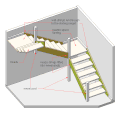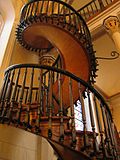Gallery
- A sketch of a stair with two quarter-space landings showing three types of newel posts
- The joint between the string and newel as seen from the stairwell
- The joint between the string and newel as seen from the stair
- Illustration of a box newel
- A cast iron spiral staircase showing the central newel post that supports the treads, risers and balustrade.
- Central newel of spiral staircase at Fort Benjamin Hawkins
- There is no newel in Loretto Chapel's spiral staircase (the "Miracle stair") in Santa Fe, New Mexico, US.









